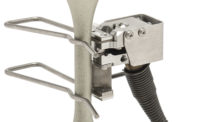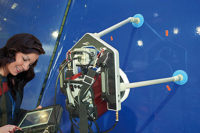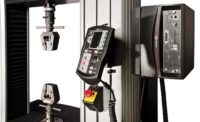Fixtures for Testing Composites
It is critical to understand the material being tested in order to choose the correct tensile setup.

Climbing drum peel fixture, ASTM D1781
Both the automotive and aerospace industries continue to drive the development of lightweight steels, stronger aluminums, and composite materials. When characterizing the materials they plan to use in their designs, engineers in these industries trust the results from universal testing machines that are able to measure force accuracies to the millinewton and displacement accuracies down to the micron. This high level of accuracy has allowed advances in materials development to leap forward while enabling engineers to tailor materials to meet the needs of their specific applications: lightening vehicles, tailoring stiffness to individual sub-assemblies, and ultimately getting a leg up on the competition.
Though an advanced testing machine may be considered the most important component of a test setup, it is just as important to consider the fixtures that hold the specimens in place inside the test space. From seemingly simple compression platens to hydraulic tensile grips, fixtures are a key component of materials testing and are used in every single type of test.
Fixturing for Tensile Tests
One of the most common but overlooked types of fixtures in destructive materials testing are tensile grips. These fixtures have a simple purpose: hold the specimen in the machine so a tensile test can be performed. Despite this basic purpose, there are a myriad of grips on the market with different actuation methods, alignment capabilities, and temperature capabilities. It is critical to understand the material being tested in order to choose the correct tensile setup.
Carbon fiber laminates are composed of individual carbon fibers that have been woven into a matrix and bound together using epoxy or another type of thermoplastic polymer. The resulting composite material typically exhibits an extremely high strength-to-weight ratio, making it ideal for applications where strength and rigidity are key. Despite drawbacks in formability, carbon fiber laminates are now competing for space in industries typically dominated by steel and aluminum. By modifying the woven matrix within a composite, engineers can create materials and components that exhibit a certain set of material properties when tested in one direction and an entirely different set of properties when tested in another. This anisotropic behavior means that an airplane wing can be designed to be flexible in one direction but remain rigid in another.
Anisotropic behavior makes carbon fiber laminates extremely sensitive to bending and misalignment when being tested in a universal testing machine. In order to eliminate sources of misalignment, manufacturers use alignment fixtures to ensure that a specimen is pulled in pure tension during the course of a test. An alignment specimen outfitted with strain gages is placed in the testing system and pulled to a specific load. The strain measured on different sides of the specimen reveals the misalignment of the system. The alignment fixture is then adjusted, typically under direction of software, in order to minimize the difference in strain and therefore bring the system into alignment. It is important to repeat this procedure if anything in the testing setup is changed that may impact the alignment of the system.

Precision manual wedge grips and alignment specimen
The tensile grips themselves have a noticeable influence over alignment that can often be overlooked. When choosing grips for alignment-critical applications it is important to keep the following in mind:
Symmetry of the grip body: Grips that are asymmetrical may elastically stretch during a test in a biased direction, imparting bending on the specimen.
Actuating mechanism: If choosing a manually actuated grip, it is important that the grip does not rotate when being clamped, as this can cause twisting during the test. Hydraulic solutions provide repeatable clamping and are available with variable clamping pressures, allowing for slip mitigation while avoiding crushing the composite sample.

End loading compression fixture, ASTM D695
Specimen centering devices: Many grips can accommodate physical stops that improve operator repeatability when inserting a specimen. This can also ensure that specimens are inserted with the length of the specimen parallel to the test space.
These alignment considerations allow the operator to ensure that the test is performed without bending the specimen, which can cause premature failure. Many manufacturers also follow the guidance given by Nadcap AC7122-1 for testing non-metallic aerospace and automotive materials or Nadcap AC7101 for testing metallic materials.
Fixturing for Compressive Tests
Compression fixtures mimic the loading modes that the materials will be subjected to in their various applications. Manufacturers will typically use a wide range of fixture types in order to simulate these real-world scenarios. Unlike isotropic metals, the properties of a composite may differ dramatically in these different states.
Compressive tests on composite laminate prove especially difficult due to the laminate’s weakness when bent and weakness between layers. These weaknesses cause the laminate to buckle unless supported properly. End loading of the samples (ASTM D695, ISO 14126 Method 2) can be done by using fixtures designed to support the laminate along its length, prohibiting buckling during compression between platens.
Other fixture variants combine different types of loading. For example, ASTM D6641 combines shear loading with end loading. These fixtures typically support the laminate sample along a portion of its length, allowing for shear stress to accumulate in the center of the sample.

Compression after impact fixture, ASTM D7137
Fixturing for Shear Tests
Composite laminate structures are notably weak between carbon weave layers where most of the strength is dependent on the strength of the epoxy used in the construction. A variety of fixtures can be used to determine the strength of this bond as well as the shear strength of the layers themselves.
Inter-laminar shear strength (ASTM D2344, ISO 14130) is typically tested in a guided flexure configuration, while the testing of layers between composite structures is performed with other fixtures such as sandwich flatwise tension fixtures (ASTM C297) and climbing drum peel fixtures (ASTM D1781).
All of these configurations are aimed at characterizing the strength of the composite when out-of-plane forces are exerted on a component. Shear fixtures are also used to measure in-plane properties in v-notch shear tests (ASTM D5379, ASTM D7078).
Impact Damage Tests
Unlike other materials used in automotive and aerospace applications, composite structures typically do not possess the ability to plastically deform. While a fender bender in your car may result in a dent, a composite structure may instead crack, compromising the structural integrity of the component. This makes it extremely important for manufacturers to assess the strength of composites that have been subjected to impact damage. Compression after impact tests (AITM 1-0010, ASTM D7137) characterize a composite’s residual strength after it has undergone inter-laminar damage.
Initial impact testing is typically performed using a drop tower outfitted with an anti-rebound device. This drop tower damages the composite structure with a single strike that can be replicated on other samples. The sample is then subject to compressive loads while supported in an anti-buckling fixture to determine the change in residual strength.

Fatigue rated hydraulic wedge grips
Conclusion
All materials testing is performed with some combination of fixtures working together to ensure that the sample is held in place while the test is performed. The fixtures used for testing composite materials play a critical role in ensuring that a test is correctly performed. Without paying special attention to the fixtures and their correct usage, tests and their results become meaningless. In addition to the common fixtures discussed in this article, there are countless others that are being used by the automotive and aerospace industries in order to ensure that materials meet the needs of manufacturers across the globe. Q
Looking for a reprint of this article?
From high-res PDFs to custom plaques, order your copy today!






